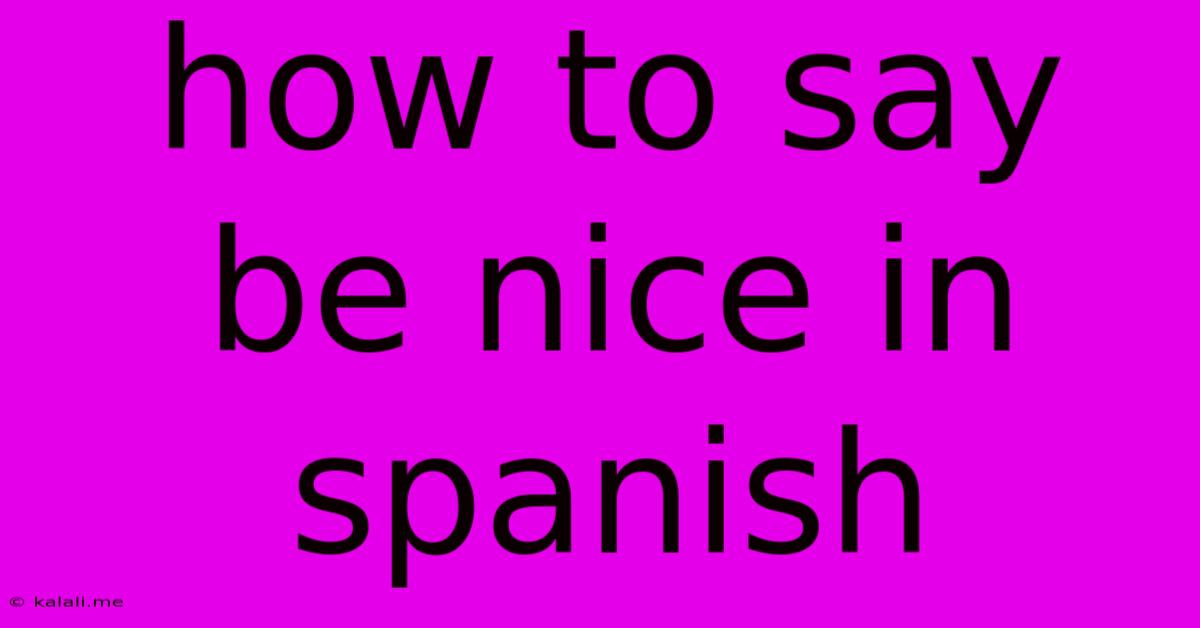How To Say Be Nice In Spanish
Kalali
May 22, 2025 · 3 min read

Table of Contents
How to Say "Be Nice" in Spanish: A Comprehensive Guide
Want to express kindness and consideration in Spanish? Knowing how to say "be nice" isn't just about a direct translation; it's about understanding the nuances of Spanish culture and choosing the right phrase for the context. This article will explore various ways to express this sentiment, from formal to informal, and provide you with the tools to navigate different social situations. This guide covers everything from simple phrases to more nuanced expressions, ensuring you can communicate effectively and politely in Spanish-speaking environments.
There's no single perfect translation for "be nice," as the best choice depends heavily on the situation and your relationship with the person you're addressing. Let's explore several options:
Common Ways to Say "Be Nice" in Spanish
-
Sé bueno/a: This is the most straightforward translation, using the imperative form of the verb "ser" (to be). "Bueno" is used for boys/men, and "buena" for girls/women. This is a gentle, child-like way to say "be good" or "be nice". It's suitable for children or in very informal settings.
-
Sé amable: This translates to "be kind" or "be amiable" and is a more formal and versatile option than "sé bueno/a." It's appropriate for most situations where you want to encourage someone to be polite and considerate.
-
Por favor, sé cortés: This translates to "please, be courteous." Adding "por favor" (please) adds a layer of politeness, making it suitable for formal situations or when addressing someone you don't know well. Cortés implies a higher level of politeness and respect than just being "nice."
-
Ten cuidado: This translates to "be careful," which can imply "be nice" indirectly, especially when referring to actions towards others. For instance, "Ten cuidado con lo que dices" (Be careful what you say) suggests being mindful of one's words and therefore being polite.
Choosing the Right Phrase: Context Matters
The best way to say "be nice" in Spanish depends heavily on the context:
-
Talking to children: "Sé bueno/a" or "Sé amable" are perfectly acceptable.
-
Addressing adults in a friendly setting: "Sé amable" works well.
-
Formal settings or addressing someone you don't know well: "Por favor, sé cortés" is the most appropriate choice.
-
Expressing concern for someone's behavior: "Ten cuidado" might be a better option than directly telling someone to "be nice."
Going Beyond the Literal: Nuances and Alternatives
Beyond direct translations, you can convey the sentiment of "be nice" through other phrases that emphasize kindness and consideration:
-
Trata a los demás con respeto: This means "treat others with respect," a powerful and effective way to encourage good behavior.
-
Recuerda ser considerado/a: This translates to "remember to be considerate," emphasizing the importance of thoughtful actions.
-
Sé comprensivo/a: This translates to "be understanding" and is particularly useful when you want someone to be empathetic and forgiving.
Mastering the art of saying "be nice" in Spanish involves understanding the subtle differences in meaning and choosing the phrase that best suits the specific situation. By utilizing these options and considering the context, you can effectively communicate your message and maintain positive relationships in Spanish-speaking environments. Remember, practice makes perfect!
Latest Posts
Latest Posts
-
How To Run Power To A Shed
May 22, 2025
-
How To Shut Off House Alarm
May 22, 2025
-
How Do I Turn Apple Tv Off
May 22, 2025
-
How To Test An Immersion Heater
May 22, 2025
-
How Do You Pray 3 Witr
May 22, 2025
Related Post
Thank you for visiting our website which covers about How To Say Be Nice In Spanish . We hope the information provided has been useful to you. Feel free to contact us if you have any questions or need further assistance. See you next time and don't miss to bookmark.